It seems a very informal seed exchange has sprouted up in my little corner of the garden blogger zone. (Heh, heh--I said a seed exchange has sprouted! Oh, geez, I'm good!!!)
Lisa, my number one garden blogger idol (an awkward, ineffective locution meant to communicate that I am her Number One Fan) sent me some Prunella vulgaris, a plant she was shocked to see me enthusing about. In exchange, I sent her some Digitalis purpurea 'Apricot Beauty'.
(I sent some of that off to the County Clerk too. Why, I guess you could say, I'm...wait for it...spreading my seed! Damn!)
Anyhow, I've been on a seed buying/gathering binge in the last few days. I wasn't sure if it was worth blogging about, but when Lisa's Prunella arrived today (thanks, Lisa!), I took it as a sign from God that he wants me to blog about my seed purchases. And let's face it, I haven't had much to say in a week or two.
Also, you may not have noticed, I reorganized the links. There's now a section just for purveyors of seed and plant. These are sources I use.
So, what seeds did I get?
From J.L. Hudson:
Delphinium californicum DELP-26 1 packet $2.00
Delphinium cardinale DELP-28 1 packet $3.00
Penstemon Palmeri PENS-121 1 packet $2.00
Jacaranda mimosifolia JACA-16 1 packet $2.00
Camassia quamash CAMA20 1 packet $2.00
Alonsoa meridionalis ALON-16 1 packet $2.00
Sphaeralcea ambigua SPHA-4 1 packet $2.00
I'm trying to amend the order to include Ricinus communis 'Camencita'. About that plant, a satisfied customer wrote, "The leaves are a luminous purple in full sun, and the impossibly bright, carmine red seed pods seem to glow from within." Oh, yeah.
You may recall I reported that Betsy Clebsch extolled the virtues of Delphinium cardinale--how nice to find the seeds for sale.
Hudson extolls the D. californicum in the 2007 catalog supplement. "Light blue-green to purplish three-quarter inch flowers in long, dense, 20-inch racemes in April to July. Vigorous hardy perennial to 7 feet, with palmately divided 6-inch leaves. California. Drought resistant. Magnificent. Germinates readily in 3-6 weeks." Sold.
I'm going to try the drought-loving native from the Great Basin, Penstemon palmeri, on my roof. Why not--it "needs hot, dry sunny places with well-drained gravelly soil." Annie's sells this in 4" pots. She describes "large pink flowers are fragrant and have beautiful nectar guides in their throats". Sold.
I bought Jacaranda seeds on a whim. Pam once inquired in the comments whether we grow it here. We do. It's everywhere, but not on Bernal Heights. At least not that I've noticed on Bernal Heights. It was blooming in May/June, and driving around town then, I kept thinking "Must take pictures of Jacaranda to show Pam." Never did tho'.
Bulbs are so expensive, and really not that hard to grow from seed, I decided to give Camassia a whirl. Alonsoa is a florific garden plant from Chile. I bought this cultivar, and I love it. So now, the species. Sphaeralcea ambigua is a mallow from the southern deserts. I didn't have good luck with desert native Calliandra eriophylla, but maybe the mallow will be better.
That's not all the seeds I bought. I found this Underwood Gardens place when I was cleaning out my web browser's bookmarks. No idea when I bookmarked it, or where I learned about it. Anyhow from them, I bought a few freak-o vegetables.
1 x Wonderberry (SYWB 40) = $2.75
1 x Asparagus Pea (PLT 07) = $3.00
1 x Alpine Strawberry, Red (FFV 48R) = $3.00
1 x Tomato, Black Cherry (TBC 66) = $3.00
1 x Radish, Red Meat Winter / Watermelon (RARM 11) = $2.50
1 x Pea, Snow, Oregon Giant Sugar Pod (PSO 01) = $2.50
1 x Fire n Ice (SYSS 32) = $3.00
1 x Cucamelon / Mouse Melon (SYMS 41) = $3.50
1 x Cosmos, Bright Lights (FECP 64) = $0.00
Wonderberry, Solanum Burbankii, was invented by California plantsman Luther Burbank in 1909.
Fire n Ice, Solanum sisymbrifolium. That's Underwood's spelling. When you do a Google search, it wants to know if you meant Solanum sisymbriifolium. And then you find out it's called Sticky Nightshade and it's toxic, but you can eat the fruit when fully ripe. I don't even know if I'll be able to get it fully ripe in San Francisco's mild summers. Between this and the Ricinus, I might die y'all!
What excited me first about the Underwood seeds was the Cucamelon, aka Mexican Sour Gherkin, Melothria scabra. That was the first thing I knew I wanted to buy from them, but if I wasn't such an impulse shopper, I would have found seeds for sale much cheaper in the J.L. Hudson catalog. Half the price, in fact.
Oh, well--whatever. What else is going on in my world of seeds...
If I'm going to sow Prunella, why not Purslane?
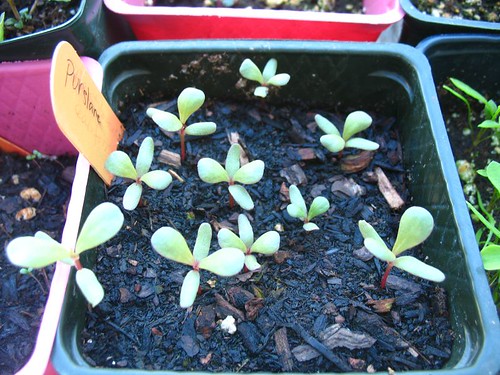
And to go with that, Miner's Lettuce.
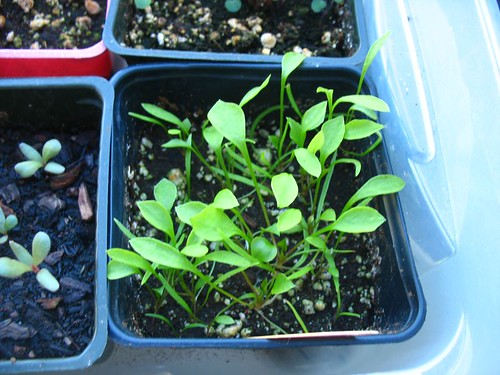
These columbine took forever, but they finally came up.
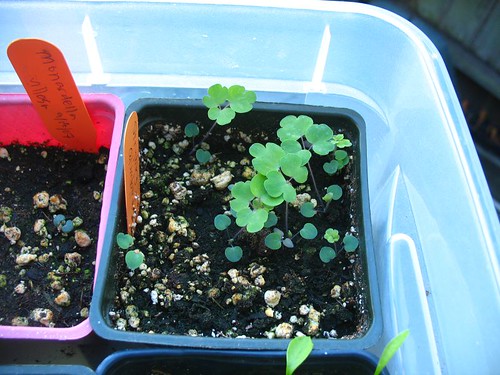
Native perennial Keckiella brevifolia. White flowers, I think. I think I potted up ten of these on Sunday. I'll keep one and give the rest to the Botanical Garden for the plant sale.

Also recently potted up, Lilium pardilinum. I grew these from seed and just potted up the dormant bulb. Some sources say wait two years, but I found one reliable source who said it's okay after one year. Good enough for me. Fingers crossed.
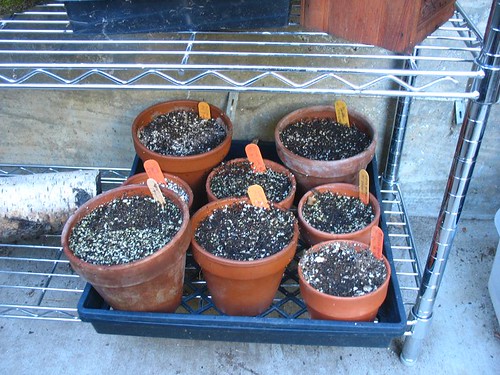
And this is Evergreen Huckleberry, Vaccinium ovatum. I tried potting up a few of these recently, and they all died. I'm going to let them get bigger before I try again. In the meantime, I top-dressed the sowing medium with potting mix to get some nutrients in there. Tho' I'm not sure if they want any nutrients, being ericaceous and all...
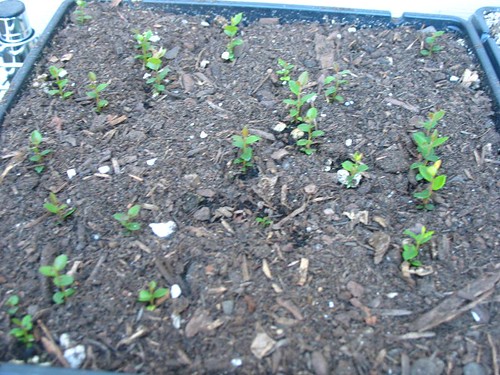

8 comments:
"This video is no longer available"??!?
Lisa's pretty great.
I thought miner's lettuce was purslane?
And congratulations on getting Aquilegia (A formosa?) to grow from seed; after 2 years I gave up and bought plants the other day.
One of my few native seed successes has been Keckiella cordifolia maybe I'll trade you for a brevifolia one of these days.
Well, my miner's lettuce is Claytonia perfoliata. I don't know the botanical name for purslane--I should tho'. Both sets of seeds came from Territorial.
I grew Keckiella cordifolia from seed too. I'll give you a K. brevifolia. And a columbine too, if you want it.
I'm not sure where the columbine seeds came from. It could very well be the 2' Strybing form with purple flowers because a gardener there gave me a seedhead last year.
Or I pinched it from my dad's garden and there's no telling what it is. It's definitely not Aquilegia formosa.
I had a hard time with columbine seeds too. This was my second try, and germination took at least two months.
Thank you for this post, Chuck! (And not just because you mentioned me! ;-) I'm glad your columbine finally came up! It's fun to see what all you've ordered...inspires me to spring for some seeds, too. Purslane and Miner's lettuce? Are you and Guy gonna have some salads? I hear Miner's lettuce is very nutritious, and I thought that people eat purslane, too. Glad to see your source links too, as I am always looking for places to try out. That alonsoa is very pretty, and the wonderberry interests me, as well as the huckleberry (pretty much anything to do with berries is cool by me!)...but the solanum, well I think you'll be safe. After all, aren't tomatoes in the nightshade family too? Anyhow, I look forward to progress updates. And JVA-thank you!
Tomatoes, and potatoes too, are in the Nightshade family (Solanaceae). So how bad can it be?! :)
Purslane is supposed to be high in omega fatty acids--one of the ones you can't get from fish, I think. And miner's lettuce has unsurpassed crunch. Anyhow, yeah, I want these weedy lettuces to spread and propagate because greens are year-round in mild coastal weather. And we do eat a lot of salads.
I am envious of all your seeds, except for the purslane. Purslane is a WEED in my garden. I know it is supposed to be good to eat, but it is a WEED in my garden.
Congrats on the D. cardinale. I'm a big fan of the red delphiniums and they'll be in my garden one day (especially the short D. nudicauli that I see growing along the road sides).
Purslane is Portulaca something, but Claytonia is in the same family (Portulacaceae). I've got a bunch of Claytonia sibirica naturally growing in my yard and the leaves taste great.
Whoreticulture Gardens are sooo small that weeding isn't really a problem.
Literally, I could rip every plant out of my garden (except for the bamboo) in an hour.
Hmmm....sounds like a blog meme.
Also, most of the garden does not get watered and I don't think purslane will spread in an unwatered CA garden.
Post a Comment